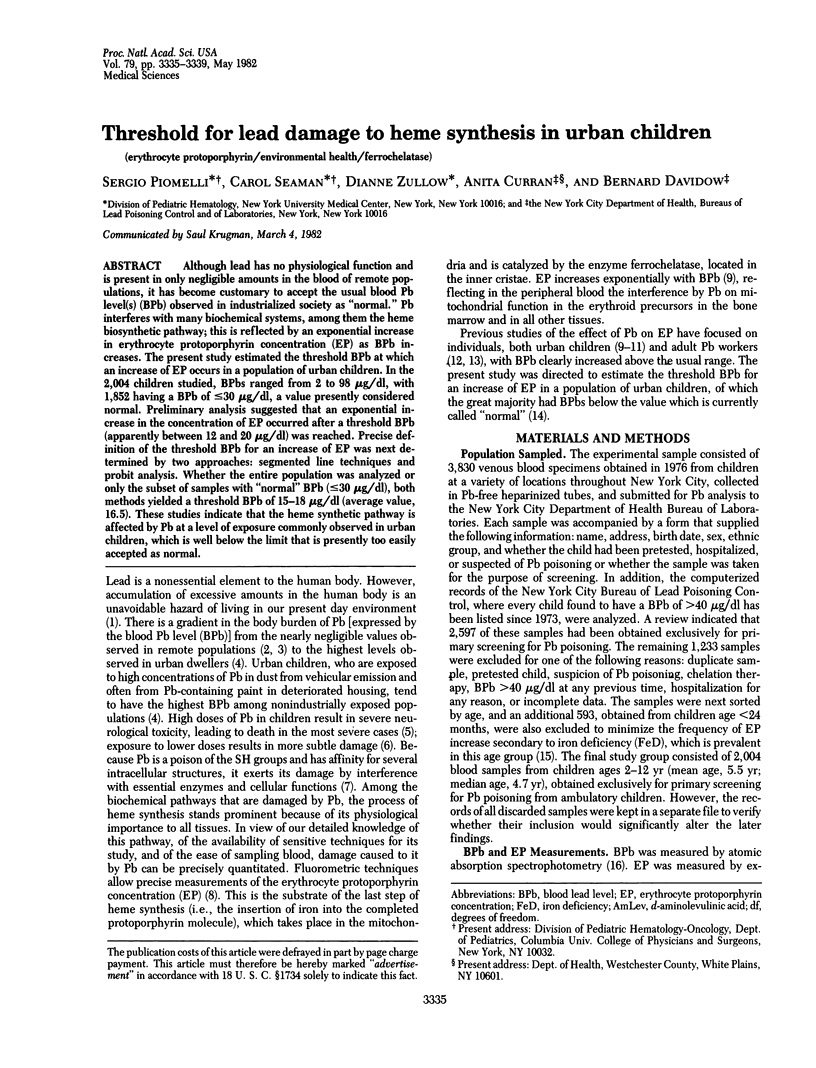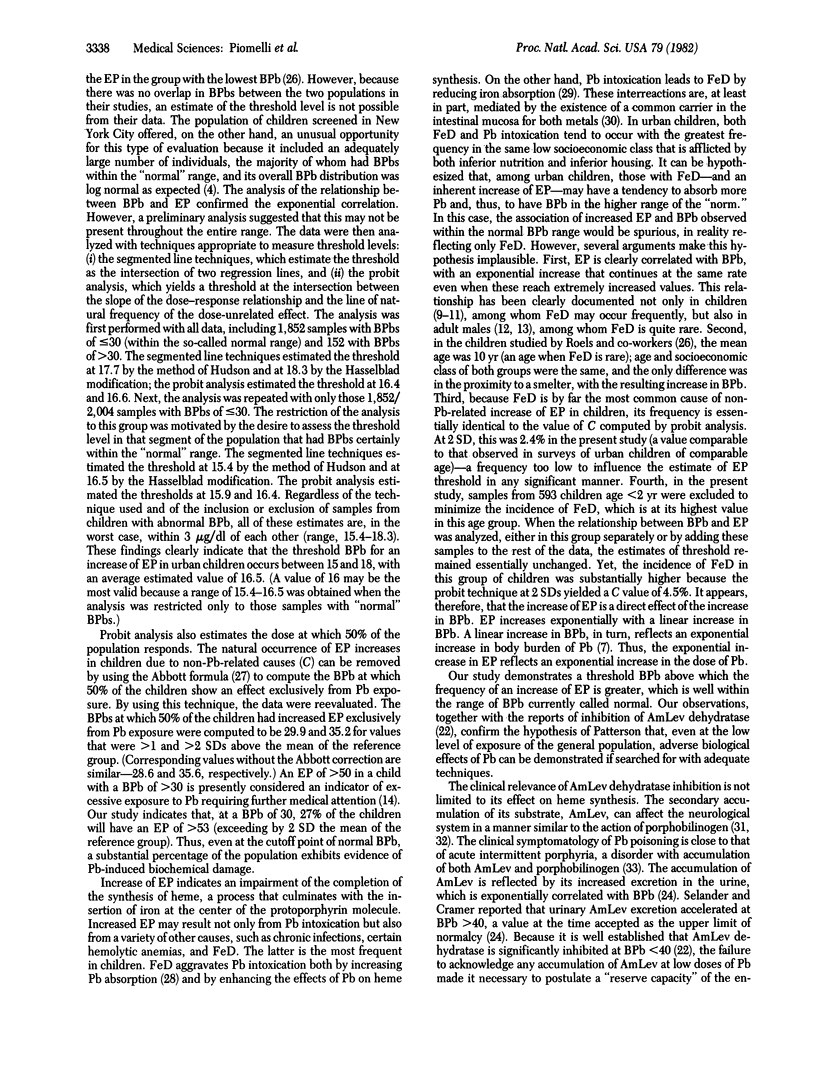Abstract
Although lead has no physiological function and is present in only negligible amounts in the blood of remote populations, it has become customary to accept the usual blood Pb level(s) (BPb) observed in industrialized society as "normal." Pb interferes with many biochemical systems, among them the heme biosynthetic pathway; this is reflected by an exponential increase in erythrocyte protoporphyrin concentration (EP) as PBb increases. The present study estimated the threshold PBb at which an increase of EP occurs in a population of urban children. In the 2,004 children studied, BPbs ranged from 2 to 98 micrograms/dl, with 1,852 having a BPb of less than or equal to 30 micrograms/dl, a value presently considered normal. Preliminary analysis suggested that an exponential increase in the concentration of EP occurred after a threshold BPb (apparently between 12 and 20 micrograms/dl) was reached. Precise definition of the threshold BPb for an increase of EP was next determined by two approaches: segmented line techniques and probit analysis. Whether the entire population was analyzed or only the subset of samples with "normal" BPb (less than or equal to 30 micrograms/dl), both methods yielded a threshold BPb of 15-18 micrograms/dl (average value, 16.5). These studies indicate that the heme synthetic pathway is affected by Pb at a level of exposure commonly observed in urban children, which is well below the limit that is presently too easily accepted as normal.
Full text
PDF




Selected References
These references are in PubMed. This may not be the complete list of references from this article.
- Alessio L., Bertazzi P. A., Monelli O., Foà V. Free erythrocyte protoporphyrin as an indicator of the biological effect of lead in adult males. II. Comparison between free erythrocyte protoporphyrin and other indicators of effect. Int Arch Occup Environ Health. 1976 Jun 3;37(2):89–105. doi: 10.1007/BF00378056. [DOI] [PubMed] [Google Scholar]
- Barton J. C., Conrad M. E., Nuby S., Harrison L. Effects of iron on the absorption and retention of lead. J Lab Clin Med. 1978 Oct;92(4):536–547. [PubMed] [Google Scholar]
- Becker D., Viljoen D., Kramer S. The inhibition of red cell and brain ATPase by delta-aminolaevulinic acid. Biochim Biophys Acta. 1971 Jan 5;225(1):26–34. doi: 10.1016/0005-2736(71)90280-x. [DOI] [PubMed] [Google Scholar]
- DAGG J. H., GOLDBERG A., LOCHHEAD A., SMITH J. A. THE RELATIONSHIP OF LEAD POISONING TO ACUTE INTERMITTENT PORPHYRIA. Q J Med. 1965 Apr;34:163–175. [PubMed] [Google Scholar]
- Ericson J. E., Shirahata H., Patterson C. C. Skeletal concentrations of lead in ancient Peruvians. N Engl J Med. 1979 Apr 26;300(17):946–951. doi: 10.1056/NEJM197904263001703. [DOI] [PubMed] [Google Scholar]
- Farkas W. R., Stanawitz T., Schneider M. Saturnine gout: lead-induced formation of guanine crystals. Science. 1978 Feb 17;199(4330):786–787. doi: 10.1126/science.622568. [DOI] [PubMed] [Google Scholar]
- Flanagan P. R., Hamilton D. L., Haist J., Valberg L. S. Interrelationships between iron and lead absorption in iron-deficient mice. Gastroenterology. 1979 Nov;77(5):1074–1081. [PubMed] [Google Scholar]
- Grandjean P., Nielsen O. V., Shapiro I. M. Lead retention in ancient Nubian and contemporary populations. J Environ Pathol Toxicol. 1979 Jan-Feb;2(3):781–787. [PubMed] [Google Scholar]
- Granick J. L., Sassa S., Granick S., Levere R. D., Kappas A. Studies in lead poisoning. II. Correlation between the ratio of activated to inactivated delta-aminolevulinic acid dehydratase of whole blood and the blood lead level. Biochem Med. 1973 Aug;8(1):149–159. doi: 10.1016/0006-2944(73)90018-5. [DOI] [PubMed] [Google Scholar]
- Hecker L. H., Allen H. E., Dinman B. D. Heavy metal levels in acculturated and unacculturated populations. Arch Environ Health. 1974 Oct;29(4):181–185. doi: 10.1080/00039896.1974.10666565. [DOI] [PubMed] [Google Scholar]
- Hernberg S., Nikkanen J. Enzyme inhibition by lead under normal urban conditions. Lancet. 1970 Jan 10;1(7637):63–64. doi: 10.1016/s0140-6736(70)91846-5. [DOI] [PubMed] [Google Scholar]
- Lin-Fu J. S. Vulnerability of children to lead exposure and toxicity (first of two parts). N Engl J Med. 1973 Dec 6;289(23):1229–1233. doi: 10.1056/NEJM197312062892306. [DOI] [PubMed] [Google Scholar]
- Nathanson J. A., Bloom F. E. Lead-induced inhibition of brain adenyl cyclase. Nature. 1975 May 29;255(5507):419–420. doi: 10.1038/255419a0. [DOI] [PubMed] [Google Scholar]
- Needleman H. L., Gunnoe C., Leviton A., Reed R., Peresie H., Maher C., Barrett P. Deficits in psychologic and classroom performance of children with elevated dentine lead levels. N Engl J Med. 1979 Mar 29;300(13):689–695. doi: 10.1056/NEJM197903293001301. [DOI] [PubMed] [Google Scholar]
- Owen G. M., Kram K. M., Garry P. J., Lowe J. E., Lubin A. H. A study of nutritional status of preschool children in the United States, 1968-1970. Pediatrics. 1974 Apr;53(Suppl):597–646. [PubMed] [Google Scholar]
- PATTERSON C. C. CONTAMINATED AND NATURAL LEAD ENVIRONMENTS OF MAN. Arch Environ Health. 1965 Sep;11:344–360. doi: 10.1080/00039896.1965.10664229. [DOI] [PubMed] [Google Scholar]
- Pentschew A. Morphology and morphogenesis of lead encephalopathy. Acta Neuropathol. 1965 Nov 18;5(2):133–160. doi: 10.1007/BF00686515. [DOI] [PubMed] [Google Scholar]
- Piomelli S. A micromethod for free erythrocyte porphyrins: the FEP test. J Lab Clin Med. 1973 Jun;81(6):932–940. [PubMed] [Google Scholar]
- Piomelli S., Corash L., Corash M. B., Seaman C., Mushak P., Glover B., Padgett R. Blood lead concentrations in a remote Himalayan population. Science. 1980 Dec 5;210(4474):1135–1137. doi: 10.1126/science.7444442. [DOI] [PubMed] [Google Scholar]
- Piomelli S., Davidow B., Guinee V. F., Young P., Gay G. The FEP (free erythrocyte porphyrins) test: a screening micromethod for lead poisoning. Pediatrics. 1973 Feb;51(2):254–259. [PubMed] [Google Scholar]
- Roels H., Bruaux P., Buchet J. P., Claeys-Thoreau F., Lauwerys R., Lafontaine A., Hubermont G., Van Overschelde J. Impact of air pollution by lead on the heme biosynthetic pathway in school-age children. Arch Environ Health. 1976 Nov-Dec;31(6):310–316. doi: 10.1080/00039896.1976.10667241. [DOI] [PubMed] [Google Scholar]
- Sassa S., Granick J. L., Granick S., Kappas A., Levere R. D. Studies in lead poisoning. I. Microanalysis of erythrocyte protoporphyrin levels by spectrophotometry in the detection of chronic lead intoxication in the subclinical range. Biochem Med. 1973 Aug;8(1):135–148. doi: 10.1016/0006-2944(73)90017-3. [DOI] [PubMed] [Google Scholar]
- Sassa S., Whetsell W. O., Jr, Kappas A. Studies on porphyrin-heme biosynthesis in organotypic cultures of chick dorsal root ganglia. II. The effect of lead. Environ Res. 1979 Aug;19(2):415–426. doi: 10.1016/0013-9351(79)90066-5. [DOI] [PubMed] [Google Scholar]
- Selander S., Cramér K. Interrelationships between lead in blood, lead in urine, and ALA in urine during lead work. Br J Ind Med. 1970 Jan;27(1):28–39. doi: 10.1136/oem.27.1.28. [DOI] [PMC free article] [PubMed] [Google Scholar]
- Six K. M., Goyer R. A. The influence of iron deficiency on tissue content and toxicity of ingested lead in the rat. J Lab Clin Med. 1972 Jan;79(1):128–136. [PubMed] [Google Scholar]
- Stockman J. A., 3rd, Weiner L. S., Simon G. E., Stuart M. J., Oski F. A. The measurement of free erythrocyte porphyrin (FEP) as a simple means of distinguishing iron deficiency from beta-thalassemia trait in subjects with microcytosis. J Lab Clin Med. 1975 Jan;85(1):113–119. [PubMed] [Google Scholar]
- Tomokuni K., Ogata M. Relationship between lead concentration in blood and biological response for porphyrin metabolism in workers occupationally exposed to lead. Arch Toxicol. 1976 Aug 18;35(4):239–246. doi: 10.1007/BF00570265. [DOI] [PubMed] [Google Scholar]


